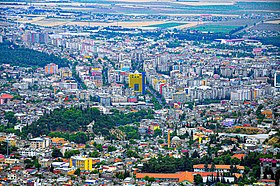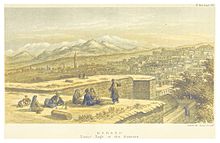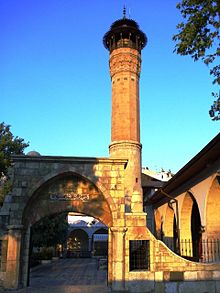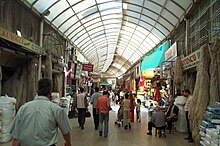Kahramanmaraş
| Kahramanmaraş | ||||
|
||||
 View of the new town of Kahramanmaraş City |
||||
| Basic data | ||||
|---|---|---|---|---|
| Province (il) : | Kahramanmaraş | |||
| Coordinates : | 37 ° 35 ' N , 36 ° 57' E | |||
| Residents : | 1,089,038 (2014) | |||
| Telephone code : | (+90) 344 | |||
| Postal code : | 46,000 | |||
| License plate : | 46 | |||
| Structure and administration (as of 2019) | ||||
| Mayor : | Hayrettin Güngör ( AKP ) | |||
| Website: | ||||
Kahramanmaraş , or Maraş for short ( Armenian Մարաշ Marash , Kurdish Mereş or Gurgum , in ancient times Germanicia or Germanikeia ), is a city in the province of the same name Kahramanmaraş in the southern part of Anatolia in Turkey , about 100 km north of the Syrian border and around 150 km east-northeast of the city of Adana . Since a territorial reform, Kahramanmaraş has been a Büyükşehir Belediyesi (city municipality) and is therefore identical to the province in terms of area and population.
geography
Geographical location
Kahramanmaraş is 549 m above sea level in the western foothills of the Taurus Mountains , on the edge of a fertile plain on the southern slope of Ahirdağ , near the southern connection to three important passes. The surrounding region is mountainous and has rich mineral deposits, mainly iron and silver . The Ayvalı Dam is 20 km to the east .
Climate table
| Kahramanmaraş | ||||||||||||||||||||||||||||||||||||||||||||||||
|---|---|---|---|---|---|---|---|---|---|---|---|---|---|---|---|---|---|---|---|---|---|---|---|---|---|---|---|---|---|---|---|---|---|---|---|---|---|---|---|---|---|---|---|---|---|---|---|---|
| Climate diagram | ||||||||||||||||||||||||||||||||||||||||||||||||
| ||||||||||||||||||||||||||||||||||||||||||||||||
|
Average monthly temperatures and rainfall for Kahramanmaraş
|
||||||||||||||||||||||||||||||||||||||||||||||||||||||||||||||||||||||||||||||||||||||||||||||||||||||||||||||||||||||||||||||||||||||||||||||||||||||
history
Antiquity
Mar'as ( Marqas ) was the capital of the Neo-Hittite kingdom of Gurgum in the Iron Age . When the Assyrians took over the empire in 711 BC. Marqas became provincial capital and seems to have remained so until the end of the Assyrian Empire.
The Roman emperor Caligula named it after his father Germanicus in Germanicia Caesarea to. This name was used under the Byzantines as Germanikeia . The Crusaders named the city Sebastia .
The Arabs captured the city around 645 and used it as a base for incursions into Asia Minor. Several times during the Arab-Byzantine- Armenian struggles destroyed, the city was by the Umayyad - Caliph I. Mu'awiya (7th century) and rebuilt to 800 by the Abbasids -Kalifen Harun al-Rashid extended.
middle Ages

From 1071 Maraş became the government center of Philaretos Brachamios , who created his own power base in the southeast of the Byzantine Empire after the defeat of the emperor Romanos IV. Diogenes in the battle of Manzikert around 1071. Antioch and Edessa also belonged to his territory . After the death of his Philaretos officer took Tatul rule in Maraş and was built by Emperor I. Alexios recognized.
The Crusaders of the First Crusade briefly occupied Maraş around 1097, Baldwin I of Jerusalem conquered Maraş in 1103 and incorporated it into the Principality of Antioch . In 1114 the city was destroyed by an earthquake, according to the chronicle of Matthias von Edessa 40,000 people were killed, which is probably an exaggeration. The effects of the disaster could be felt as far as Sis . In 1135 the Danish manids besieged Maraş unsuccessfully. In 1146 Baldwin of Maras fell while trying to retake Edessa against Nur ad-Din on the side of Joscelin II . His successor Reinhold von Maraş fell in the battle of Inab in 1149 , whereupon the dethroned Joscelin II took power in Maraş as Reinhold's brother-in-law, but fled from the attack of the Rum Seljuks under Sultan Mas'ud I in 1150 , who then fled the city took. Apparently the city later came to Nur ad-Din, who gave Maraş to Prince Mleh of Lesser Armenia in 1171 in exchange for a high-ranking Byzantine prisoner.
As the small Armenian kingdom in the 14th century by the Egyptian Mamluks was smashed, came under the rule of Maraş Dulkadir before the city in 1515 under Sultan Selim I the Ottoman Empire was.
At the end of the 19th century, the city was in Vilayet Aleppo and was the capital of a sanjak . It made a great impression at that time, had 25 mosques , several Armenian churches, numerous public baths and 10-15,000 inhabitants, including many Armenians . The Turkish red ( Kermes ) dyers, weavers and comb makers stood out among the craftsmen .
20th century
In 1919 French troops occupied the city of Maraş and the surrounding province. Resistance to the occupiers was initiated by the scholar Sütçü İmam , it spread quickly and the residents were able to defeat the French. Many citizens died in the process, which a place called Kanlıdere (English: "Bloody Brook") still bears witness to. In 1973, Maraş was honored with the name Kahraman (German: "heroic") for the resistance . The victory there over General Gouraud's French battalions motivated people in all parts of the country to resist the occupation forces. This was followed by the liberation of Urfas and Anteps , who were given the honorary names Gaziantep (German: “victorious Antep”) and Şanlıurfa (German: “glorious Urfa”). Kahramanmaraş is the only city to have been awarded the İstiklâl Madalyası ( Medal of Independence ) because the city liberated itself before the Kuvayı Milliye ( Ataturk militia ) troops intervened.
The three-week battle for Maraş in 1920 was also accompanied by massacres of the Armenians , who had resettled in the region after the genocide. Turkish gangs threw kerosene-soaked rags on Armenian houses and set a barrage in front of the American Aid Hospital . The Armenians sought refuge in churches and schools. Women and children found temporary shelter in the six Armenian Apostolic and three Armenian Evangelical churches and the city's only Catholic cathedral. The Armenian legionaries tried to defend them but were overwhelmed. All the churches and ultimately all the Armenian districts were set on fire. The fate of the Armenians worsened when the French decided to withdraw on February 10th. When the 2,000 Armenians who found refuge in the Catholic cathedral tried to follow the retreat, they fell victim to Turkish rifles and machine guns.
Initial reports put the Armenian death toll at 16,000, which was later revised to 5,000 to 12,000, which are now considered the more reliable figures.
1978 pogrom
After several violent clashes and unrest, two teachers were shot dead on December 21, 1978. During the funeral the next day, clashes broke out again, in which two people died again. On December 23, supporters of the right-wing MHP party attacked Alevi neighborhoods in Kahramanmaraş. There were 31 dead and 150 injured. Despite the relocation of additional army units to Kahramanmaraş on December 24, the groups could not be prevented from further attacks. The government declared a state of emergency in the 13 provinces in southeastern Turkey . According to official information, 111 people have died. According to unofficial statements from the local population, over 1,100 people were killed. The government cited a conflict between left and right as the motive for the attacks.
21st century
In December 2012, it was decided to station around 400 Bundeswehr soldiers in the city as part of Operation Active Fence from January 2013, which are to operate Patriot anti-aircraft missiles there due to the civil war in Syria . On December 30, 2015, the German contribution to the Active Fence mission ended with the withdrawal of the last soldiers.
Population development
According to the statistical office of Turkey, 228,129 people lived in Kahramanmaraş in 1990. The 2000 census showed the population increased to 326,198. Currently (2013) 575,000 people live in the city.
Numerous Armenian families lived in Maraş until the genocide of the Armenians in 1915 . Those survivors of the genocide who fled to Armenia founded the district of Nork-Marasch ( Yeni Maraş in Turkish ) in Yerevan .
Culture and sights
Buildings and natural monuments
The city is culturally rich. There are many old buildings worth seeing and an interesting old town. Many old small streets, craft shops and the medieval citadel form the core of the city center. There are also covered bazaars , large shopping streets and very good patissiers. There are also some mosques , including the Ulu Cami from the 15th century , as well as Hatuniye and Beyazit from the Ottoman era, Koran schools - especially the Taş Medresesi (15th century) - and some churches from the Byzantine period. In addition, the third largest mosque in Turkey, the Abdulhamithan Camii (capacity of around 10,000 people) is also in Kahramanmaraş. The river Ceyhan flows west of the city and is dammed here to form three reservoirs. Other attractions include mountain meadows, lakes, springs, waterfalls and stalactite caves. The Archaeological Museum is located at Azerbaycan Bulvarı , which has a rich collection of Hittite sculptures.
Culinary specialties
The region's specialty is Maraş Dondurması ice cream , which is traditionally made from goat's milk and the snow from Mount Ahırdağ . This ice cream has an elastic, chewing gum-like consistency. It got into the Guinness Book of Records when it was stretched from one power pole to another, or when it was frozen to buses so that they could be lifted over the ice with a crane.
Other specialties are bulgur pockets filled with walnuts and meat (Maraş İçli Köfte) , a salty and sour soup with lots of herbs (Ekşili Çorbası) and Maraş Tarhanasi . This wheat dough with yoghurt, dried in plates, can be eaten pure or roasted, but it can also be made into a soup. The soup Kelle Paça made from sheep's head and shank of sheep is also prepared in the province. The red hot chilli from Maraş is also known.
Economy and Infrastructure
traffic
Maraş is connected to the Adana - Malatya train line by a branch line . A country road leads via Türkoğlu to the Otoyol 52 motorway from Adana to Gaziantep . The Kahramanmaras Airport is served by Turkish Airlines daily from Istanbul and Ankara and the private airline Pegasus Airlines three times a week.
education
The Sütçü-İmam-Universität-Kahramanmaraş (Turkish: Kahramanmaraş Sütçü İmam Üniversitesi ) was founded in 1992, it has been constantly expanded since its foundation and in 2007 consists of seven faculties, ten vocational colleges, two technical colleges, three institutes, ten research centers , as well as six departments subordinate to the rectorate. There are four different campuses, although the most modern campus (Avşar campus) has not yet been completed.
economy
The city is a center for industry and trade. Olive oil, spices and textiles are produced and exported. The city is one of the largest textile producing cities in Turkey. The main employers are large fabric factories, so the city is the market leader in the Turkish textile industry. Another mainstay of the economy in Kahramanmaraş is the production of traditional ice cream. Carved furniture, as well as copper, silver, and brass work are also valued. In the surrounding area, mainly wheat, rice and legumes are grown, the Ceyhan river is used to irrigate the fields.
health
The city has several hospitals.
- Kahramanmaraş Ağız ve Diş Sağlığı Merkezi
- Sütçü İmam Üniversitesi Araştırma ve Uygulama Hastanesi
- Kahramanmaraş Necip Fazıl Şehir Hastanesi
- Kahramanmaraş Özel Hayat Hastanesi
Personalities
- Leon III (around 680 - 741), Byzantine emperor between 717 and 741
- Sareh I (1915–1963), Catholicos of the Great House of Cilicia of the Armenian Apostolic Church
- Berç Sahak Turan (1920–1997), Turkish architect and senator of Armenian origin
- Vahit Kirişci (* 1960), agricultural engineer , university professor and politician
- Şeref Eroğlu (* 1975), wrestler
Web links
Individual evidence
- ^ Turkish Institute for Statistics ( Memento December 9, 2015 on WebCite ), accessed December 9, 2015
- ↑ Steven Runciman: History of the Crusades. CH Beck, Munich 2001.
- ↑ Per Law No. 1657 of February 7, 1973, Official Gazette No. 14446 of February 12, 1973, p. 1 ( PDF file; 1.9 MB )
- ^ The Massacre Of Armenians . The Times , February 28, 1920.
- ↑ Eyewitness Tells How Armenians Were Massacred . The New York Times , February 29, 1920.
- ^ Hovannisian, Richard G. The Postwar Contest for Cilicia and the 'Marash Affair' in Armenian Cilicia , eds. Richard G. Hovannisian and Simon Payaslian. UCLA Armenian History and Culture Series: Historic Armenian Cities and Provinces, 7. Costa Mesa, CA: Mazda Publishers, 2008, p. 509.
- ↑ French : Muré, Materne (1921). Un episode de la tragédie arménienne: le massacre de Marache (février 1920) . Brussels: Société Belge de Libraire.
- Jump up ↑ Kerr, Stanley E. The Lions of Marash: Personal Experiences with American Near East Relief, 1919-1922. Albany: State University of New York Press, 1973, pp. 95-142.
- ↑ Sahakyan. Turkish-French Relations , pages 150-52.
- ^ Richard G. Hovannisian: The Republic of Armenia: From London to Sevres, February - August 1920 . Ed .: University of California. Vol. 3. Berkeley 1996, ISBN 0-520-08803-4 , pp. 41 .
- ^ Documents on British Foreign Policy, 1919-1939 . 1st series. Eds. Rohan Butler and JPT Bury. Issue VII.London: HM Stationery Office, 1958, p. 303.
- ↑ Kerr. The Lions of Marash , p. 196.
- ^ The difficult fate of the apostates in FAZ from February 25, 2013, page 3
- ↑ Thomas Wiegold : augengeradeaus.net. Thomas Wiegold, December 12, 2012, accessed December 17, 2012 .
- ↑ Archive link ( Memento of the original from October 6, 2014 in the Internet Archive ) Info: The archive link was inserted automatically and has not yet been checked. Please check the original and archive link according to the instructions and then remove this notice.




